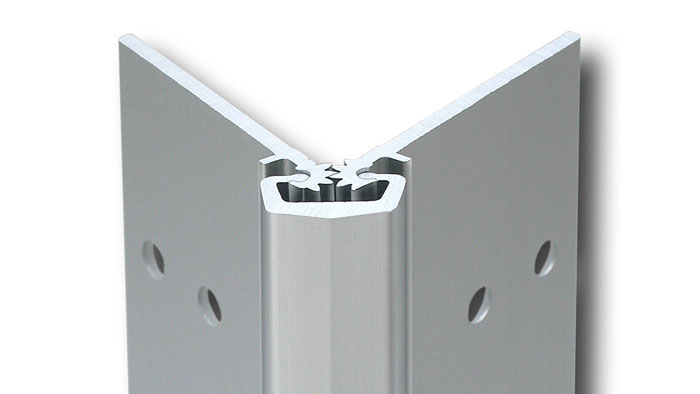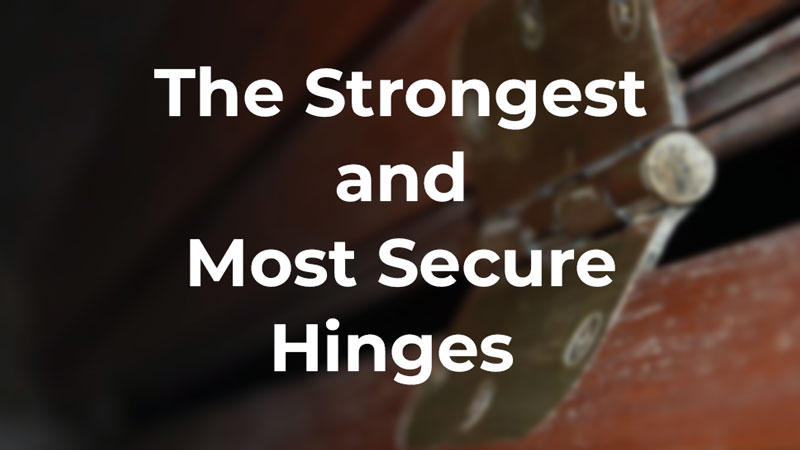Hinges are essential but often overlooked components of most standard doors. While their primary function is to allow the door to swing, they’re also critical from a security standpoint.
Whether you want to improve home security or need your door to bear heavy loads, sturdy hinges are crucial.
So, what are the strongest hinges?
The strongest type of hinge is the continuous hinge, also known as the piano hinge. Certain heavy-duty models can hold up to 900 pounds of weight. Another strong alternative is a Gorilla hinge. If security is a concern, you may also want to consider using multiple security butt hinges.
If you want to know how you can get the most out of your hinges and learn about the recommended models, keep reading.
In this article, I’ll explain which types and models are the most secure and robust, and how you can reinforce your existing hinges if you don’t want to replace them.
The Strongest and Most Secure Types of Hinges
First, let’s see the types of door hinges and features you want to consider when you need a strong and secure setup.
Continuous Hinges
A continuous hinge, also known as a piano hinge, is an extended hinge that runs from the very bottom to the top of the door, and spans the entire length of the door.
A continuous hinge is more durable and stronger than a regular hinge, some heavy-duty models can support up to 900 pounds (1). However, a standard piano hinge can typically bear less weight than this.
These types of door hinges provide more stability and can bear heavier loads than conventional hinges as they distribute the weight of the door evenly over the full length of the jamb.
Continuous hinges are an ideal choice for doors that are subject to frequent and heavy use. ANSI/BHMA Grade 1 hinges are certified for 2.5 million cycles of opening and closing (2).
Another benefit of continuous hinges compared to butt hinges is that they significantly reduce the risk of a sagging door.
Here are the main types of continuous hinges:
Pin and barrel continuous hinges
These are the most common types of continuous hinges. Their anatomy is very similar to standard butt hinges: they have two leaves with a barrel (or knuckles) in the middle which contains a pin that joins the leaves.
They’re usually made from stainless steel which makes them really strong and robust.
Full mortise (the hinge is installed on the edge of the door) and full surface (the hinge is installed on the face of the door) mounting types are available.
In general, pin and barrel continuous hinges can hold a door weighing up to 600 pounds (3).
Geared continuous hinges

These hinges use gears with interlocking teeth covered by a cap. When you open or close the door, the swinging motion is executed and allowed by these gears instead of pins.
Geared continuous hinges are usually made from extruded aluminum which is not as strong as stainless steel but very durable and resistant to corrosion. These door hinges are often used in commercial and public spaces.
In general, geared continuous hinges can hold a door up to 450 pounds (3).
Key takeaways:
If you need strength, consider using pin and barrel continuous hinges. In most cases, they provide better support and resilience than multiple standard hinges, and they’re a perfect choice if you need a strong hinge. A piano hinge can be used for both commercial and residential doors and can hold up to 600 pounds.
Example: Markar FM300 Edge Mounted Stainless Steel Pin & Barrel Continuous Hinge (supports weights up to 600 lbs)
Gorilla Heavy Duty Hinge
A Gorilla hinge is made from carbon steel. It’s designed for heavy gates and doors where high forces act on the post or the door frame. It’s often used for driveway gates, for example.
A Gorilla heavy duty hinge is rated to 1,000 pounds per pair. This flat mount hinge features a tamper-proof welded pin design and a hardened roller bearing. It allows for a 180-degree swing which makes it a great choice for outdoor gates.
For large and extra heavy gates, a Gorilla hinge is probably your best bet.
Example:
Security Hinges
Most security hinges are visually very similar to standard butt hinges. However, they come with some unique features that make them more secure and resistant to external attacks.
Several types of security hinges exist on the market:
Stud hinges have one or multiple tamper-proof security studs on one leaf that go into the corresponding holes on the opposite hinge leaf. This feature improves security by preventing the door from taking down and removing it from its place in a closed position.
Door hinges with a non-removable pin make it very hard to knock the pin out of the barrel, even if someone has access to the hinges from the outside.
Set-screw hinges prevent the removal of the pin with the help of a set screw inserted into the barrel and the pin itself.
Security hinges can’t hold as much weight as piano hinges, but they’re a must for outward-opening doors where the hinges are exposed.
Example:
Read more on how you can secure door hinges here.
Pivot Hinges
If your interior door is extremely heavy, you may want to consider using pivot hinges instead of standard continuous hinges.
These hinges are installed on the bottom and top sides of the door, allowing it to rotate around these two fixed points.
This design makes it relatively easy to open and close a large and heavy door. A pivot hinge is pretty durable and strong but it’s not recommended for exterior doors. The reason for this is that the bottom hinge will corrode easily if it’s exposed to water or humidity frequently. Complicated installation and limited opening range are other drawbacks of pivot hinges.
Example:
Materials
Whether you need a strong hinge for your front door or garage door, you can’t ignore what it’s made from. The design, the built quality, and the material are all critical when it comes to strength and durability.
In most cases, steel and wrought iron hinges will bear more weight than other metals. For exterior doors or outdoor gates, you want to use stainless steel or coated wrought iron, as they don’t corrode.
Wrought iron is susceptible to corrosion, so always make sure some kind of protective coating is applied that makes it rust-resistant, such as galvanizing, oil-based coating, or bluing.
Important: Before you mount any hinges on your door, always carefully study and follow the manufacturer’s instructions. If you fail to do so, the hinges may not be able to support the maximum weight specified in the user manual.
How to Reinforce Your Existing Hinges
The hinges are often one of the weakest parts of a door. However, you don’t necessarily have to replace your existing units to make them stronger and more secure.
If the existing hinges are not rusted or otherwise damaged and they function properly, you can easily reinforce them in most cases.
Here’s how you can do that:
- Replace the existing screws. If the existing screws are short and weak (or rusted), you can significantly improve the load-bearing capacity of the hinges by replacing them with longer screws. Use at least 3-in. screws made from stainless steel. Screws with a higher gauge (diameter) will also contribute to making the hinge stronger.
- Install a hinge reinforcement plate. This metal hardware is designed to add extra security and stability to the existing hinges. You need to install this under the old hardware.
- Add extra hinges. Another way to increase the strength of your door hinges is to simply add more of them without removing the existing units.
- Install hinge shields. If you want to make your hinges more secure, consider adding hinge shields to your door. These devices are installed over the existing hinges and they make the hinged side of the door much more resistant to force attacks. Note, this step won’t increase the load-bearing capacity of the hinges.
If your door is sagging or it’s hard to close, you may not be able to fix your existing hinges. In these cases, you’re better off replacing them.
Strong hinges will not only bear heavier loads but also help to prevent your door from being kicked in.
Photos: Wikimedia (PerryBallard)















